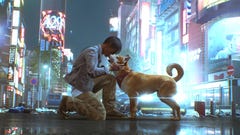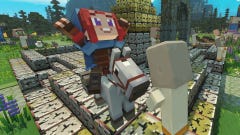Ghostwire: Tokyo review: Tango’s gorgeous Tokyo is haunted by urban legends and too much filler
You’ve been Tangoed
Many creators leave fingerprints on their games, but few apply their digits as physically as Shinji Mikami in Ghostwire: Tokyo. One sidequest in Tango’s open world spook-busting adventure sees a neighbourhood disturbed by piano music, eerily plonking away at ungodly hours. Roaming the streets you soon catch the haunting strains of Moonlight Sonata, a piece famously played in Mikami’s Resident Evil to unlock a secret passage. But it’s more than a cute nod. Ghostwire’s credits reveal the player to be Mikami himself - showing off talents usually reserved for fellow Bethesda creators behind closed doors.
While I’m sure he contributed more than tinkling mood music for an optional quest, Ghostwire has been framed as a debutante ball for the next generation of Tango talent. In Archipel’s ace interview series Mikami spoke about fostering new creative leads and taking more of a backseat compared to his work on The Evil Within, which was more clearly made in the Resi mold. The result is, by design, the studio’s least Mikami-ish romp to date: a sprawling tale of a metropolis turned ghost town that is one part love letter to the city and its urban legends, and an opportunity to zap headless school girls and floating puppets with electrifying particle effects.
After the unrelenting anxiety of The Evil Within, this is certainly a more chilled time. It’s not remotely scary, for one. Its cast of backflipping highschoolers and umbrella-wielding salarymen have more in common with cartoonish spirits of Luigi’s Mansion than the J-horror abominations of Tango’s earlier game. Okay, I winced the first time a scissor-waving giantess (big Lady Dimitrescu energy) snipped out my soul and stripped my combat abilities, but even she’s easily robbed of her power with a paralysis trap and a rocket to the face. The whole thing carries the air of giggling kids sharing sleepover spook stories than anything seriously traumatising.
Mechanically, it’s far from survival horror, though it taps into some familiar rhythms. Combat revolves around three elemental projectiles - wind (pistol), water (shotgun) and fire (rockets) - fuelled with crystals yanked from stunned attackers. Here it shares something with modern Doom: you chew through ammo fast and restock by getting up close and personal. And so it becomes about prioritising enemies: getting rid of ranged hassle or healers first, working out who you can treat as a walking ammo box, etc. In busier waves, especially at a lower level, I sensed the same crowd control kicking in that served me so well in Resident Evil 4. There’s a throughline in there somewhere.
.jpg?width=690&quality=80&format=jpg&auto=webp)
Not that you’d see it playing on regular difficulty, which is generously tailored for exploration and hassle-free fights. I’d say to the point that combat becomes shapeless, a simple target gallery where ghosts crumple after a few wind bullets to the chest. Hard difficulty is where Ghostwire’s clutch finds the bite and its systems make sense. Elements like stealth takedowns and a bow that lets you thin a crowd before a fight, or floor-based traps that can stun, distract or leave a phantom susceptible to a heart-ripping takedown. Without that slight hint of desperation, these are just unneeded lumps bobbing in a soup of repetition.

Even then, it’s an experience that loses its sting as it progresses. There’s not much enemy variety, for starters, with one too many variations on schoolkids and brolly-bashers making it hard to discern hour twenty from hour one, bar a gradual release of mini-bosses into the general enemy population. But even these bigger, nastier ghouls - a blizzard-summoning monk figure or a toothy gob attached to spider limbs - are easily accounted for. You basically just sit on your superpowered ‘wiring in’ mode (charged up by pulling cores in regular combat) and unleash it when anything remotely nasty turns up. Bustin’ makes me feel... not a whole lot, actually?
Overuse of regular enemies is noticeable in side quests. You’ll meet spirits who can’t move on until you’ve investigated an apocryphal local legend: a trash vortex, the apartment block lift with one floor button too many, or a studio head who won’t stop playing Beethoven. The setups wrap basic ‘go here, do this’ tasks in stories that, according to review notes, are lifted from the developers’ lives: what creepy fun! But that most tales end fighting common fodder robs them of that drama. The dark pull that lures people to a suicide hotspot in a tenement building? It’s another dude with an umbrella. Just like that, creepypasta becomes limp, overcooked penne.
.jpg?width=690&quality=80&format=jpg&auto=webp)
The dark pull that lures people to a suicide hotspot in a tenement building? It’s another dude with an umbrella. Just like that, creepypasta becomes limp, overcooked penne.
Map filler is equally disappointing; the sure sign of a team not really knowing what to do with the open world they’ve built. Like the side quests with their urban legends, the game puts a folklore skin on drudgery: you’re chasing sickle-handed dust devils through forests, you’re chasing long-necked Rokurokkubi down alleys, you’re chasing living cloth Ittan-momen across rooftops... you’re chasing a lot of things, basically. Strip away the art design and it’s no more engaging than pursuing endless wind-swept papers in Assassin’s Creed. Arguably, it’s worse here, as Ghostwire’s versions are bizarrely easy. Many last for all of ten seconds; barely a distraction.
Then there’s harvesting souls of Tokyo’s vanished population: hundreds upon hundreds of blue clouds crammed down alleys and sprinkled on rooftops. Collecting these constituted the meat of my playtime, as they are needed to both level up and unlock the true ending of the game (full disclosure: I called it a day at 182,000 of 240,000 collected). I likened it to Crackdown’s orb hunt in my preview, and I think that’s apt: one cluster inevitably puts you near another, and the next thing you know you’ve lost an hour to tidying up. It’s a good podcast game - why not try EWS as you mindlessly tick off trinkets? - but lacks the complex traversal to be more than that. Outside of a longer glide and a late ability to grapple to any rooftop (gutting whatever aerial navigation challenge existed) it just plods ever on.
.jpg?width=690&quality=80&format=jpg&auto=webp)
.jpg?width=690&quality=80&format=jpg&auto=webp)
.jpg?width=690&quality=80&format=jpg&auto=webp)
.jpg?width=690&quality=80&format=jpg&auto=webp)
Picking over the nooks and crannies does make you drink in Ghostwire’s one truly standout element: the city itself. As mentioned in my earlier hands-on, this is a neat bit of first-person tourism; it opens with a gorgeous rendition of Shibuya’s traffic crossing before pulling you into a warren of shouty shop fronts and up a towering spire that riffs on Shibuya Sky (for trademark reasons, I’d imagine, few places use real-world names). If your setup can handle ray tracing this is especially pretty; Tokyo’s wall-to-wall billboards turn a sea of puddles into a rainbow extravaganza. But even without it, the artificial luminance of the city, and combat’s focus on elemental whooshes and leashes made of sizzling light, make this a flashy world to behold.
But it’s actually when the game leaves the more iconic landmarks that it got under my skin, pushing into suburbs and forgotten social projects, far from the tourist traps. Yes, it helps that everyone has vanished, but even so, the fringes of the map carry more of a supernatural throb to them - especially the disquieting, looming apartment complexes built to accommodate the post-war urban boom. Here, in these uniform blocks, marked with stark lettering and soundtracked with the cawing of birds, the game finally finds the chilling effect that can’t quite take root in busier areas. It’s a side of Tokyo I’ve not seen in much pop culture and feels like something that only a team fully embedded in the city’s history would tap into.
.jpg?width=690&quality=80&format=jpg&auto=webp)
I just wish they had the confidence to let the city breathe without plastering it with pick-ups. It’s hard to see the authentic character under the more artificial climbing frame they’ve used it for. Because there are moments of genuine magic here: the sudden appearance of a ghostly parade through Shibuya, say, or the signalling of a certain enemy’s approach by the sight of road markings detaching from the tarmac and wafting in the air. Or just the very neat repeated trick of streetlights burning an angry red when the ghosts spot you, as if the whole infrastructure was throwing a wobbly. Here the city is a canvas for unnerving happenings, rather than a holding pen for seen-it-all-before time wasting.
In a roundabout way, this is a mission success for hands-off Mikami - Ghostwire certainly doesn’t feel like something he’s made. It’s too baggy, too loose, lacking the powerhouse momentum I associate with his previous work. What’s here just never clicks fully into place: a beautiful setting, tactile combat, tantalising hints of the beyond, but not enough to populate a city this big, leaving stodge to fill the vacuum. Mikami’s tinkling ivories aside, Ghostwire is a tad too discordant.
.jpg?width=880&quality=80&format=jpg&auto=webp)

















